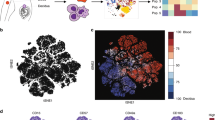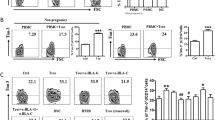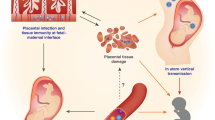Abstract
Decidual natural killer (dNK) cells are believed to be critical for maintaining maternal/fetal tolerance and regulating placental vascular remodeling based upon their abundance and unique phenotype during early pregnancy. However, the mechanism for how the dNK cells play such important roles in successful pregnancy remains undefined. Here, we identified a subtype of dNK cells characterized as having a CD3−CD56brightCD25+ phenotype. We found that CD56brightCD25+ NK cells preferentially localize to the maternal/fetal interface during early human pregnancy. CD25+ dNK cells account for approximately 75% of CD25-expressing decidual immune cells (DICs). However, less than 5% of CD25-positive peripheral blood mononuclear cells are CD25+ NK cells. Furthermore, CD25+ and CD25− dNK cells exhibit distinct phenotypes: CD25+ dNK cells display a more activated phenotype and greater cytokine-secreting capacity. Interestingly, coculture of peripheral NK (pNK) cells with primary trophoblasts upregulates the percentage of CD25-expressing pNK cells, resulting in increased expression of activation markers and cytokine production by pNK cells. In addition, we demonstrated that the CXCL12/CXCR4 axis is crucial for the recruitment of CD25+ dNK cells and contributes to the accumulation of CD3−CD56brightCD25+ dNK cells at the maternal/fetal interface. Thus, our data reveal that the crosstalk between trophoblasts and pNK cells leads to the accumulation of CD3−CD56brightCD25+ dNK cells, which exert a regulating effect at the maternal/fetal interface.
This is a preview of subscription content, access via your institution
Access options
Subscribe to this journal
Receive 12 digital issues and online access to articles
$119.00 per year
only $9.92 per issue
Buy this article
- Purchase on Springer Link
- Instant access to full article PDF
Prices may be subject to local taxes which are calculated during checkout




Similar content being viewed by others
References
Trowsdale J, Betz AG . Mother's little helpers: mechanisms of maternal–fetal tolerance. Nat Immunol 2006; 7: 241–246.
Munoz-Suano A, Hamilton AB, Betz AG . Gimme shelter: the immune system during pregnancy. Immunol Rev 2011; 241: 20–38.
Piccinni MP, Beloni L, Livi C, Maggi E, Scarselli G, Romagnani S . Defective production of both leukemia inhibitory factor and type 2 T-helper cytokines by decidual T cells in unexplained recurrent abortions. Nat Med 1998; 4: 1020–1024.
Makrigiannakis A, Zoumakis E, Kalantaridou S, Coutifaris C, Margioris AN, Coukos G et al. Corticotropin-releasing hormone promotes blastocyst implantation and early maternal tolerance. Nat Immunol 2001; 2: 1018–1024.
Xu C, Mao D, Holers VM, Palanca B, Cheng AM, Molina H . A critical role for murine complement regulator Crry in fetomaternal tolerance. Science 2000; 287: 498–501.
Ayatollahi M, Geramizadeh B, Samsami A . Transforming growth factor beta-1 influence on fetal allografts during pregnancy. Transplant Proc 2005; 37: 4603–4604.
Zhang J, Xiao X, Liu W, Demirci G, Li XC . Inhibitory receptors of the immune system: functions and therapeutic implications. Cell Mol Immunol 2009; 6: 407–414.
Somerset DA, Zheng Y, Kilby MD, Sansom DM, Drayson MT . Normal human pregnancy is associated with an elevation in the immune suppressive CD25+ CD4+ regulatory T-cell subset. Immunology 2004; 112: 38–43.
Vivier E, Tomasello E, Baratin M, Walzer T, Ugolini S . Functions of natural killer cells. Nat Immunol 2008; 9: 503–510.
Raulet DH . Interplay of natural killer cells and their receptors with the adaptive immune response. Nat Immunol 2004; 5: 996–1002.
Lanier LL . NK cell recognition. Annu Rev Immunol 2005; 23: 225–274.
Andoniou CE, Coudert JD, Degli-Esposti MA . Killers and beyond: NK-cell-mediated control of immune responses. Eur J Immunol 2008; 38: 2938–2942.
Moffett-King A . Natural killer cells and pregnancy. Nat Rev Immunol 2002; 2: 656–663.
Boyson JE, Rybalov B, Koopman LA, Exley M, Balk SP, Racke FK et al. CD1d and invariant NKT cells at the human maternal–fetal interface. Proc Natl Acad Sci USA 2002; 99: 13741–13746.
Kovats S, Main EK, Librach C, Stubblebine M, Fisher SJ, DeMars R . A class I antigen, HLA-G, expressed in human trophoblasts. Science 1990; 248: 220–223.
King A, Hiby SE, Gardner L, Joseph S, Bowen JM, Verma S et al. Recognition of trophoblast HLA class I molecules by decidual NK cell receptors—a review. Placenta 2000; 21: S81–S85.
Hanna J, Goldman-Wohl D, Hamani Y, Avraham I, Greenfield C, Natanson-Yaron S et al. Decidual NK cells regulate key developmental processes at the human fetal–maternal interface. Nat Med 2006; 12: 1065–1074.
Harris LK . Review: trophoblast–vascular cell interactions in early pregnancy: how to remodel a vessel. Placenta 2010; 31: S93–98.
Vacca P, Cantoni C, Vitale M, Prato C, Canegallo F, Fenoglio D et al. Crosstalk between decidual NK and CD14+ myelomonocytic cells results in induction of Tregs and immunosuppression. Proc Natl Acad Sci USA 2010; 107: 11918–11923.
Fu B, Li X, Sun R, Tong X, Ling B, Tian Z et al. Natural killer cells promote immune tolerance by regulating inflammatory TH17 cells at the human maternal–fetal interface. Proc Natl Acad Sci USA 2013; 110: E231–E240.
Peritt D, Robertson S, Gri G, Showe L, Aste-Amezaga M, Trinchieri G . Differentiation of human NK cells into NK1 and NK2 subsets. J Immunol 1998; 161: 5821–5824.
Deniz G, Akdis M, Aktas E, Blaser K, Akdis CA . Human NK1 and NK2 subsets determined by purification of IFN-gamma-secreting and IFN-gamma-nonsecreting NK cells. Eur J Immunol 2002; 32: 879–884.
Zhang C, Zhang J, Tian Z . The regulatory effect of natural killer cells: do “NK-reg cells” exist? Cell Mol Immunol 2006; 3: 241–254.
Saito S, Nakashima A, Myojo-Higuma S, Shiozaki A . The balance between cytotoxic NK cells and regulatory NK cells in human pregnancy. J Reprod Immunol 2008; 77: 14–22.
Wu X, Jin LP, Yuan MM, Zhu Y, Wang MY, Li DJ . Human first-trimester trophoblast cells recruit CD56brightCD16− NK cells into decidua by way of expressing and secreting of CXCL12/stromal cell-derived factor 1. J Immunol 2005; 175: 61–68.
Huang Y, Zhu XY, Du MR, Li DJ . Human trophoblasts recruited T lymphocytes and monocytes into decidua by secretion of chemokine CXCL16 and interaction with CXCR6 in the first-trimester pregnancy. J Immunol 2008; 180: 2367–2375.
Piao HL, Tao Y, Zhu R, Wang SC, Tang CL, Fu Q et al. The CXCL12/CXCR4 axis is involved in the maintenance of Th2 bias at the maternal/fetal interface in early human pregnancy. Cell Mol Immunol 2012; 9: 423–430.
Koopman LA, Kopcow HD, Rybalov B, Boyson JE, Orange JS, Schatz F et al. Human decidual natural killer cells are a unique NK cell subset with immunomodulatory potential. J Exp Med 2003; 198: 1201–1212.
Hiby SE, Walker JJ, O'Shaughnessy KM, Redman CW, Carrington M, Trowsdale J et al. Combinations of maternal KIR and fetal HLA-C genes influence the risk of preeclampsia and reproductive success. J Exp Med 2004; 200: 957–965.
Kalkunte SS, Mselle TF, Norris WE, Wira CR, Sentman CL, Sharma S . Vascular endothelial growth factor C facilitates immune tolerance and endovascular activity of human uterine NK cells at the maternal–fetal interface. J Immunol 2009; 182: 4085–4092.
El Costa H, Casemayou A, Aguerre-Girr M, Rabot M, Berrebi A, Parant O et al. Critical and differential roles of NKp46- and NKp30-activating receptors expressed by uterine NK cells in early pregnancy. J Immunol 2008; 181: 3009–3017.
Verma S, Hiby SE, Loke YW, King A . Human decidual natural killer cells express the receptor for and respond to the cytokine interleukin 15. Biol Reprod 2000; 62: 959–968.
Zhou R, Wei H, Tian Z . NK3-like NK cells are involved in protective effect of polyinosinic–polycytidylic acid on type 1 diabetes in nonobese diabetic mice. J Immunol 2007; 178: 2141–2147.
Trotta R, Dal Col J, Yu J, Ciarlariello D, Thomas B, Zhang X et al. TGF-beta utilizes SMAD3 to inhibit CD16-mediated IFN-gamma production and antibody-dependent cellular cytotoxicity in human NK cells. J Immunol 2008; 181: 3784–3792.
Aluvihare VR, Kallikourdis M, Betz AG . Regulatory T cells mediate maternal tolerance to the fetus. Nat Immunol 2004; 5: 266–271.
Sasaki Y, Sakai M, Miyazaki S, Higuma S, Shiozaki A, Saito S . Decidual and peripheral blood CD4+CD25+ regulatory T cells in early pregnancy subjects and spontaneous abortion cases. Mol Hum Reprod 2004; 10: 347–353.
Hanna J, Wald O, Goldman-Wohl D, Prus D, Markel G, Gazit R et al. CXCL12 expression by invasive trophoblasts induces the specific migration of CD16− human natural killer cells. Blood 2003; 102: 1569–1577.
Carlino C, Stabile H, Morrone S, Bulla R, Soriani A, Agostinis C et al. Recruitment of circulating NK cells through decidual tissues: a possible mechanism controlling NK cell accumulation in the uterus during early pregnancy. Blood 2008; 111: 3108–3115.
Royle C, Lim S, Xu B, Tooher J, Ogle R, Hennessy A . Effect of hypoxia and exogenous IL-10 on the pro-inflammatory cytokine TNF-alpha and the anti-angiogenic molecule soluble Flt-1 in placental villous explants. Cytokine 2009; 47: 56–60.
Torricelli M, Voltolini C, Bloise E, Biliotti G, Giovannelli A, de Bonis M et al. Urocortin increases IL-4 and IL-10 secretion and reverses LPS-induced TNF-alpha release from human trophoblast primary cells. Am J Reprod Immunol 2009; 62: 224–231.
Scott VL, Shack LA, Eells JB, Ryan PL, Donaldson JR, Coats KS . Immunomodulator expression in trophoblasts from the feline immunodeficiency virus (FIV)-infected cat. Virol J 2011; 8: 336.
Guo PF, Du MR, Wu HX, Lin Y, Jin LP, Li DJ . Thymic stromal lymphopoietin from trophoblasts induces dendritic cell-mediated regulatory TH2 bias in the decidua during early gestation in humans. Blood 2010; 116: 2061–2069.
Acknowledgements
This work was supported by the Key Project of Shanghai Basic Research from Shanghai Municipal Science and Technology Commission (STCSM) (12JC1401600 to DJL), the Key Project of Shanghai Municipal Education Commission (MECSM) (14ZZ013 to MRD) and the Nature Science Foundation from National Nature Science Foundation of China (NSFC) (NSFC31270969 to DJL; NSFC81070537, NSFC31171437 and NSFC81370770 to MRD; NSFC31300751 to HLP; NSFC81370730 to QF).
Author information
Authors and Affiliations
Additional information
Supplementary Information accompanies the paper on Cellular & Molecular Immunology's website (http://www.nature.com/cmi).
Supplementary information
Rights and permissions
About this article
Cite this article
Tao, Y., Li, YH., Piao, HL. et al. CD56brightCD25+ NK cells are preferentially recruited to the maternal/fetal interface in early human pregnancy. Cell Mol Immunol 12, 77–86 (2015). https://doi.org/10.1038/cmi.2014.26
Received:
Revised:
Accepted:
Published:
Issue Date:
DOI: https://doi.org/10.1038/cmi.2014.26
Keywords
This article is cited by
-
Bedeutung natürlicher Killerzellen in der Frühschwangerschaft
Die Gynäkologie (2022)
-
Altered Molecular Pathways and Biomarkers of Endometrial Receptivity in Infertile Women with Polycystic Ovary Syndrome
Reproductive Sciences (2022)
-
Neuromyelitis optica spectrum disorders and pregnancy: therapeutic considerations
Nature Reviews Neurology (2020)
-
Modulatory effects of trophoblast-secreted CXCL12 on the migration and invasion of human first-trimester decidual epithelial cells are mediated by CXCR4 rather than CXCR7
Reproductive Biology and Endocrinology (2018)
-
Trophoblast-derived CXCL16 induces M2 macrophage polarization that in turn inactivates NK cells at the maternal–fetal interface
Cellular & Molecular Immunology (2018)



